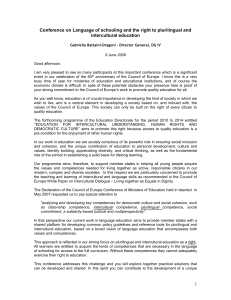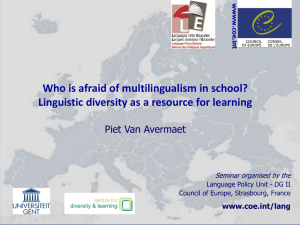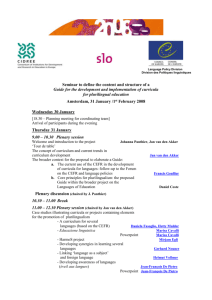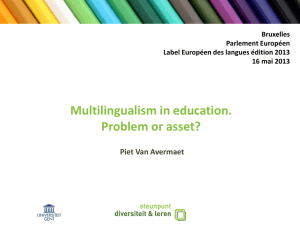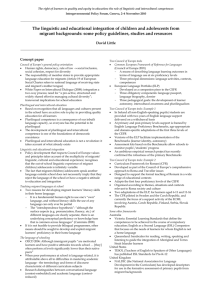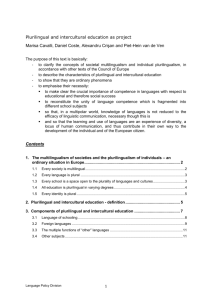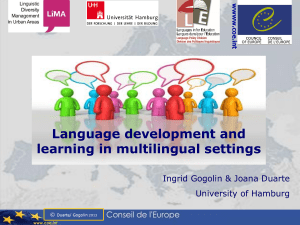Gerhard Neuner - Conseil de l`Europe
advertisement
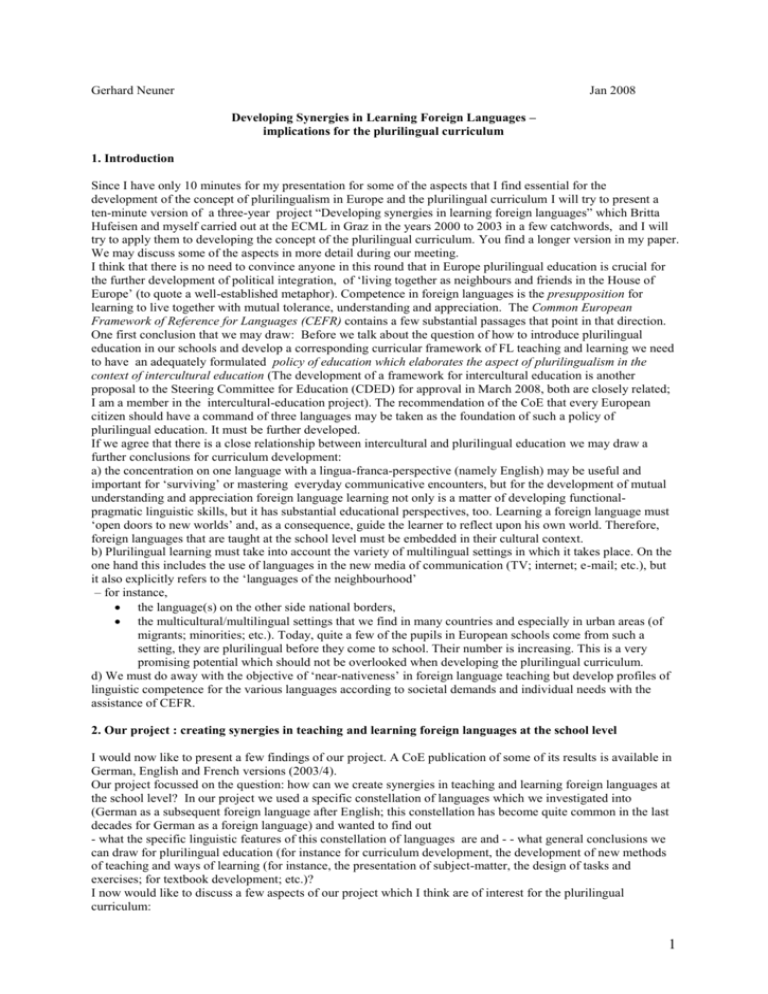
Gerhard Neuner Jan 2008 Developing Synergies in Learning Foreign Languages – implications for the plurilingual curriculum 1. Introduction Since I have only 10 minutes for my presentation for some of the aspects that I find essential for the development of the concept of plurilingualism in Europe and the plurilingual curriculum I will try to present a ten-minute version of a three-year project “Developing synergies in learning foreign languages” which Britta Hufeisen and myself carried out at the ECML in Graz in the years 2000 to 2003 in a few catchwords, and I will try to apply them to developing the concept of the plurilingual curriculum. You find a longer version in my paper. We may discuss some of the aspects in more detail during our meeting. I think that there is no need to convince anyone in this round that in Europe plurilingual education is crucial for the further development of political integration, of ‘living together as neighbours and friends in the House of Europe’ (to quote a well-established metaphor). Competence in foreign languages is the presupposition for learning to live together with mutual tolerance, understanding and appreciation. The Common European Framework of Reference for Languages (CEFR) contains a few substantial passages that point in that direction. One first conclusion that we may draw: Before we talk about the question of how to introduce plurilingual education in our schools and develop a corresponding curricular framework of FL teaching and learning we need to have an adequately formulated policy of education which elaborates the aspect of plurilingualism in the context of intercultural education (The development of a framework for intercultural education is another proposal to the Steering Committee for Education (CDED) for approval in March 2008, both are closely related; I am a member in the intercultural-education project). The recommendation of the CoE that every European citizen should have a command of three languages may be taken as the foundation of such a policy of plurilingual education. It must be further developed. If we agree that there is a close relationship between intercultural and plurilingual education we may draw a further conclusions for curriculum development: a) the concentration on one language with a lingua-franca-perspective (namely English) may be useful and important for ‘surviving’ or mastering everyday communicative encounters, but for the development of mutual understanding and appreciation foreign language learning not only is a matter of developing functionalpragmatic linguistic skills, but it has substantial educational perspectives, too. Learning a foreign language must ‘open doors to new worlds’ and, as a consequence, guide the learner to reflect upon his own world. Therefore, foreign languages that are taught at the school level must be embedded in their cultural context. b) Plurilingual learning must take into account the variety of multilingual settings in which it takes place. On the one hand this includes the use of languages in the new media of communication (TV; internet; e-mail; etc.), but it also explicitly refers to the ‘languages of the neighbourhood’ – for instance, the language(s) on the other side national borders, the multicultural/multilingual settings that we find in many countries and especially in urban areas (of migrants; minorities; etc.). Today, quite a few of the pupils in European schools come from such a setting, they are plurilingual before they come to school. Their number is increasing. This is a very promising potential which should not be overlooked when developing the plurilingual curriculum. d) We must do away with the objective of ‘near-nativeness’ in foreign language teaching but develop profiles of linguistic competence for the various languages according to societal demands and individual needs with the assistance of CEFR. 2. Our project : creating synergies in teaching and learning foreign languages at the school level I would now like to present a few findings of our project. A CoE publication of some of its results is available in German, English and French versions (2003/4). Our project focussed on the question: how can we create synergies in teaching and learning foreign languages at the school level? In our project we used a specific constellation of languages which we investigated into (German as a subsequent foreign language after English; this constellation has become quite common in the last decades for German as a foreign language) and wanted to find out - what the specific linguistic features of this constellation of languages are and - - what general conclusions we can draw for plurilingual education (for instance for curriculum development, the development of new methods of teaching and ways of learning (for instance, the presentation of subject-matter, the design of tasks and exercises; for textbook development; etc.)? I now would like to discuss a few aspects of our project which I think are of interest for the plurilingual curriculum: 1 Adopting the plurilingual perspective means adopting the perspective of the learner and having a closer look not only at the outcome, but also at the process of foreign language learning. As a consequence, apart from linguistic aspects other aspects, for instance psycho-linguistic and paedagogic questions played an important role in our project (learning a foreign language is a dynamic process: what happens in the ‘heads’ of the learners when they learn the second, third etc. language and learn about a new world? How is the new language related to languages ‘already there’ (mother tongue; first foreign language; other languages)? Which factors are essential for plurilingual learning (for instance: previous knowledge of languages (including the mother tongue); their degree of affinity; previous experience with language learning) and how do they interact and relate to each other in the head of the individual learner? ) ? Traditional foreign language didactics tended to focus on other aspects: a) aspects pertaining to the linguistic content of the curriculum (language systems (grammar; vocabulary; etc.) and their linear progression (mostly according to a rising complexity of linguistic form) b) aspects regarding the perspective of teaching subject-matter (prescriptive methods, direction of learner behaviour) c) aspects involving the monitoring of learning achievement (testing of subject material presented; marks). d) Keeping the various languages learnt ‘uncontamined’ of each other (avoidance of interferences).In the behaviourist-oriented approaches after the Grammar-Translation-Method, for instance the AutoLingual/-Visual Methods, we find a strict exclusion of the mother tongue. However, an approach to the plurilingual curriculum mainly from the traditional perspectives of linguistic subject matter (not of the learner involved), of teaching (not of learning), of testing achievement (not of selfevaluation) is problematic, because such an approach cannot comprise the complexity of the process of plurilingual learning, for instance of features of individual learning, of self-determined learning, of strategic aspects of learning and of self-evaluation. 3. Objectives of plurilingual learning In our discussion we identified two areas which are crucial for plurilingual learning – a specific language knowledge and language experience and specific strategies of language learning and communicating. Accordingly, defined two major objectives for the plurilingual curriculum: a) The development of language awareness, i.e. sensitivity to language(s), b) The development of language learning awareness and their application in specific strategies of communication ( receptive and productive skills; interaction). 3.1. Objective 1: The development of language awareness It would lead too far to present the specific linguistic aspects (areas of transfer and of interference) of the constellation of ‘German after English’. A few general observations concerning the linguistic side of the plurilingual perspective: a) Similarities in the linguistic systems can be used to build broad ‘transfer bridges’ (transfer, not interference, being the basis of dealing with linguistic aspects in the plurilingual concept), especially in the semantic area (in the constellation of ‘German after English’ there are thousands of words from various sources and referring to specific topic areas with a comprehensible meaning (from three sources: the same Germanic word stem; internationalisms; loanwords from English/American, each with an impact on specific semantic areas)), and to some extent in grammatical structures. They can be most efficiently applied in developing comprehension, especially reading comprehension (where the learner has time to form hypotheses about meaning). To develop utterance dissimilarities in pronunciation/intonation/orthography make specific exercises necessary to avoid an ‘English accent’ in speaking and writing (if I may say so). b) Specific language constellations may create a certain positive back-wash-effect from the subsequent to the previously learnt foreign language (like in the constellation ‘German after English’ the proficiency in English at an intermediate or advanced stage might be improved for instance in the area of text comprehension; cf. the EuroComRom/Germ/Slav projects). c) There is substantial evidence in research that languages are not learnt separately and stored in the brain in ‘watertight compartments’, but that there is a single language ability of human beings and thus – metaphorically speaking – there is one network for language(s) in our brain/ memory, alongside with many other interconnected networks for other knowledge and experience inventories. This has far-reaching consequences for our concept of plurilingual language learning: 1. The mother tongue is not to be excluded from fl learning. On the contrary, it forms the base and point of reference for the further development of this linguistic network in our memory. 2. Plurilinguality adds new dimensions to the language learning experiences: it contributes to the expansion of language knowledge (substantive knowledge) and of procedural knowledge (learning to learn), but it also opens the door to ‘new worlds’ beyond the world of the mother tongue. 2 3. Every learner has brings with him different preconditions and foundations into the foreign language learning process, and each learner learns differently, at least in part. Questions related to internal differentiation of teaching and to individual and autonomous learning (which is the basis for lifelong learning of foreign languages) thereby take on new significance. d) In our project with its specific constellation of acquainted languages we found that the plurilingual approach had its special benefit for the elementary stage of language learning (A1 level). The plurilingual curriculum must take all these factors into account. 3.2. The development of language learning awareness Tertiary foreign language (L 3) learning builds on the experiences of mother tongue ( L 1) and of second language learning (= L 2: first foreign language). It adds specific new dimensions to language awareness and strategies of language learning. The same applies to strategies of communication in tertiary languages. While the intercultural dimension of foreign language learning may stimulate its affective side (for instance, by developing an attitude of interest in the foreign world and motivation to learn its language), in the aspects of language awareness and language learning awareness we refer to the development of cognitive processes (for instance, realizing that languages have similar words and structures and reflecting and improving one’s own process of language learning (for instance : what is my way of learning vocabulary , of using the language as a means of communication? Can my learning and my communication in the new language be made more efficient? )). 3.3. Application of the two objectives to plurilingual learning As a result, on the basis of language awareness and language learning awareness we defined two major areas of application for the plurilingual curriculum: 1. Communicative area: developing the use of the foreign languages in everyday situations, i.e. using the various foreign languages learnt as instruments of communicative interaction 2. Intercultural area: Learning foreign languages should not only enable a person to make himself/herself understood in everyday situations, but should also lead to a better and deeper understanding of the way of life and the cultural heritage of the people of the target language community, as well as that of the learner’s own world. 4. The five didactic principles of tertiary foreign language learning We defined five major principles of tertiary language didactics: 4.1. Cognitive learning As already mentioned, it refers two the major aspects of learning: a) declarative knowledge: increasing the learner’s awareness and knowledge about languages and their cultural background, quite often developed by comparison and integration of ‘what I have in mind’ and what is new/different b) procedural knowledge: comprises insight into processes of foreign language learning (techniques and strategies), but also into the process of communication ( for instance, developing communicative strategies for utterance in face-to-face interaction; strategies of comprehension). 4.2. Comprehension as the basis and starting point for language learning I have mentioned this aspect before. Comprehension is the base of learning in general, word and text comprehension (mainly global, but also selective comprehension) may be used as the didactic foundation of plurilingual didactics. Learners must be offered appropriate redundant “language material to (intelligently) play with”. In the classroom the “silent process” of dealing with a new phenomenon/text is “put into words” in discussion. 4.3. Concentration on meaningful content In ‘German after English’ the broad field of comprehensible vocabulary allows for the selection of more meaningful topics beyond the traditional ‘everyday situations’ which dominate the first stage of fl teaching for example in the audio-lingual/-visual and communicative methods, and at a more advanced stage the development of discursive oral proficiency (discuss what you have understood and where you have problems; 3 which techniques and strategies you apply for text comprehension; etc.) which complements the ‘traditional’ development of oral exchanges in day-to-day situations. It has to be taken into account, too, that learners of subsequent languages at the school level are no longer children, but teenagers or young grown-ups with a wider horizon of interests and experiences. More interesting topics than ‘going shopping’ or ‘at the customs’ might stimulate their motivation and interest. 4.4. The text-based teaching Plurilingual learning especially implies the development of a new kind of didactics and methodology of text comprehension (for instance, selecting authentic or developing synthetic parallel texts in the various languages (including the mother tongue), which can be compared and ‘decoded’ by the learners themselves; developing specific procedures of plurilingual strategies of text comprehension) with an emphasis on global comprehension; on discussing where the learner has problems; onhow he/she goes about forming a hypothesis concerning meaning; etc.). 4.5. Developing economic procedures in the learning process At school for the offering of subsequent languages normally we have less time than for the first foreign language but it still is expected that eventually the learners achieve approximately the same level of competence. This quite often leads to time pressure, less time for exercises, and the concentration on grammar. Therefore, for plurilingual learning time-saving and efficient procedures must be developed ( for instance in the areas of presentation/explanation/exercises and tasks/evaluation) which stimulate autonomous, self-discovering, differenciate individualized, ‘intelligent’, and cooperative learning. And with some experience and creative fantasy they can be developed (cf. Kursisa/Neuner (2006).) 5 Further implications for the development of plurilingual curricula 1. We need to develop comprehensive language curricula which comprise and integrate all languages taught (developing district or school language curricula based on an explicit ‘Schulsprachenpolitik’ (an educational policy for development of languages at the school level) and may lead to different ways of organizing language teaching/lerning (for instance: phases/elements of comprehensive teaching of languages (referring to elements that comprise all languages); exchanges with partner schools; projects in and around the school). As result we may have curricular pluralism in the area of foreign languages for schools. 2. If we take the learner-oriented approach seriously we should not overlook the fact that plurilingual learning is individual learning (developing new ways of presenting input, of tasks and exercises, but also emphasising cooperation in the classroom; new role of teachers as guides; etc.). 3. Changes we may expect at the level of the various languages in the curriculum: a) a wider definition of established objectives – like language awareness/language learning awareness b) development of different profiles for the various languages in the school curriculum with the help of the CEFR c) development of different criteria for the selection and progression of subject-matter d) development of different ways of designing and presenting new learning material. e) development a new kind of tasks and exercises, of new materials as well as new ways of (self-) assessment. 6. Conclusion I think we all realise that there is a lot of exciting things to do for the development of the plurilingual curriculum – let’s tackle them! References: Hufeisen, B., Neuner, G. (2003): Mehrsprachigkeitskonzept – Tertiärsprachen – Deutsch nach Englisch, Strasbourg , CoE publication. English version (2004): The Plurilingualism Project: Tertiary Language Learning – German after English, Strasbourg. French version (2oo4) : Le concept de plurilingualisme: Apprentissage d’une langue tertiaire – L’allemand après l’ anglais, Strasbourg. Materials with a plurilingual approach: Kursisa, A., Neuner, G.(2006) : Deutsch ist easy!, München, Hueber. Neuner/Kursisa/Vicente/Pilypaityte/Cristache/Szakely (2008, forthcoming): 4 Deutsch.com, Vol 1; München: Hueber. 5
